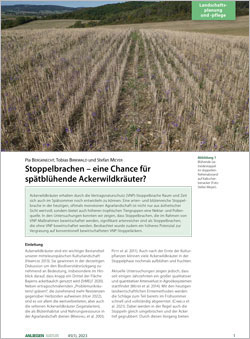Stoppelbrachen – eine Chance für spätblühende Ackerwildkräuter?
Pia Bergknecht, Tobias Birkwald und Stefan Meyer
https://doi.org/10.63653/bqya8528
Ackerwildkräuter erhalten durch die Vertragsnaturschutz (VNP)-Stoppelbrache Raum und Zeit sich auch im Spätsommer noch entwickeln zu können. Eine arten- und blütenreiche Stoppelbrache in der heutigen, oftmals monotonen Agrarlandschaft ist nicht nur aus ästhetischer Sicht wertvoll, sondern bietet auch höheren trophischen Tiergruppen eine Nektar- und Pollenquelle. In den Untersuchungen konnten wir zeigen, dass Stoppelbrachen, die im Rahmen von VNP-Maßnahmen bewirtschaftet werden, signifikant artenreicher sind als Stoppelbrachen, die ohne VNP bewirtschaftet werden. Beobachtet wurde zudem ein höheres Potenzial zur Vergrasung auf konventionell bewirtschafteten VNP-Stoppeläckern.
Summary
Stubble fallows – Chance for late-season flowering weeds?
The Contract-Based Conservation Program (CBCP) for stubble fallows give weeds both the time and space to grow even throughout the late summer months. In today’s rather monotonous agricultural landscapes a stubble fallow which is rich in both species and blossoms serves more than just an aesthetic purpose; it is an important source of nectar and pollen for Higher Level Trophic Species. As our study demonstrates stubble fallows which were farmed in the context of an CBCP prove to be significantly more specious when compared to conventionally farmed fields. Furthermore, there is a considerably increased potential for the development of invasive grasses in otherwise conventionally farmed CBCP stubble fallows.
Zum Volltext-Download:
ANLiegen Natur 45/1 (2023): 10 Seiten als Volltext herunterladen (pdf barrierefrei 1,7 MB).

 | 0
| 0 
